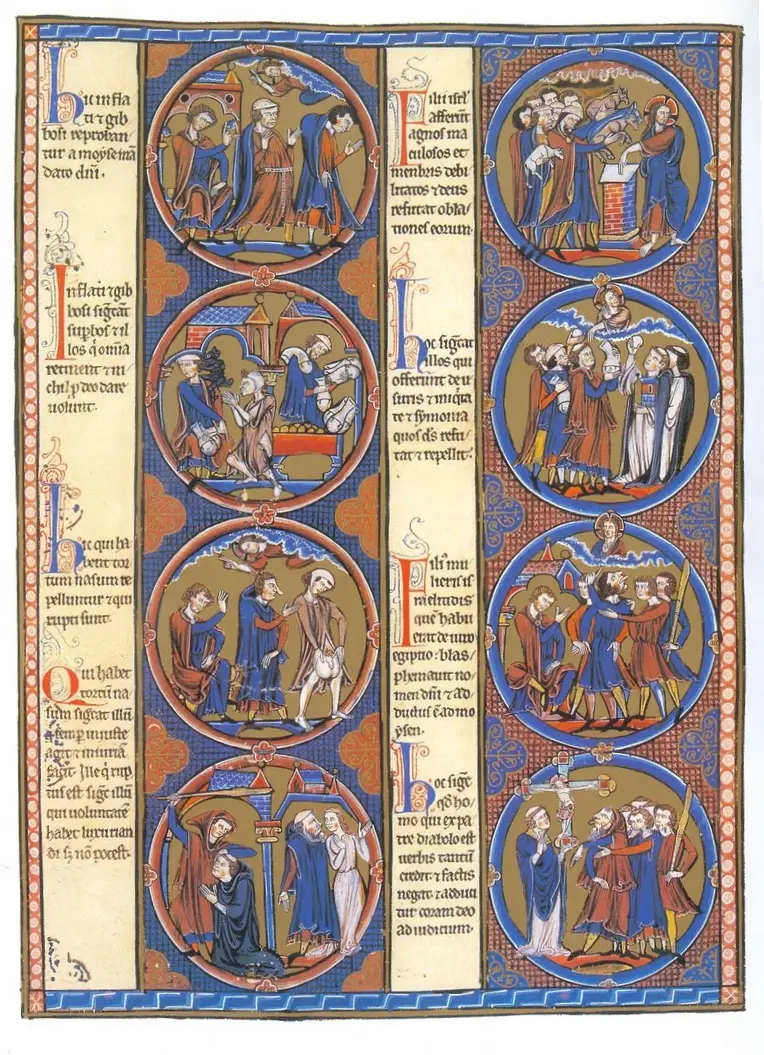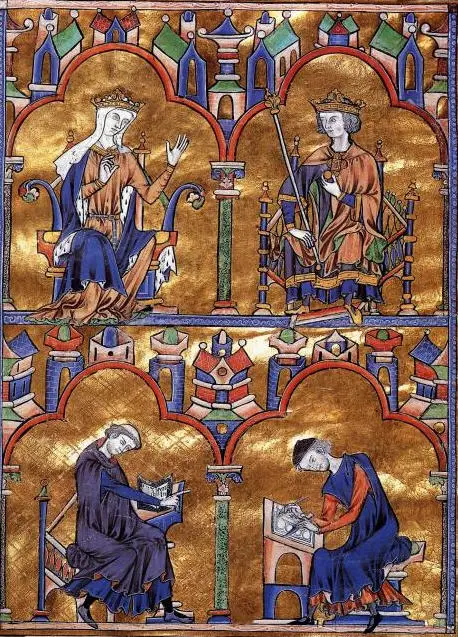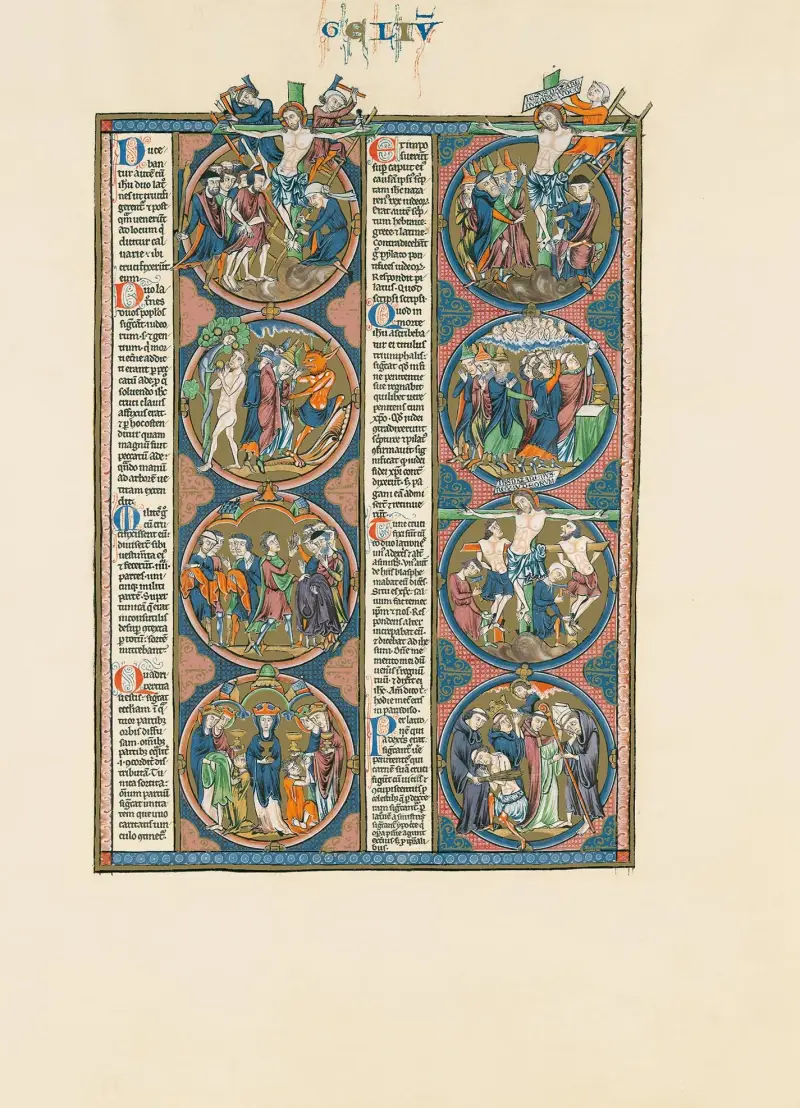"St. Louis Bible": the most illustrated Bible in the world

It is possible that this is exactly what the knights looked like, and the King of Spain Alfonso X the Wise himself, who received the “St. Louis Bible” as a gift. Still from the television series "Sid Compeador". True, Sid himself and all the kings he served lived 200 years before the reign of Alfonso X, but progress in the field of weapons at that time was extremely slow. So this appearance of them is quite acceptable!
Joshua 1:18
Literature of the Middle Ages. Over time, the spread of literacy and an increase in the total number of books in medieval Europe led to the appearance of not only copies of ancient books, but also independent works that supplemented them. Moreover, at first these were again the same biblical texts, but with comments and explanations. This is how the so-called “biblical moralizing” appeared - books that, in addition to excerpts from biblical texts, included many illustrations and explanations, both to these texts themselves and to the illustrations that explained them. Well, the “richest” in terms of illustrations today is the “St. Louis Bible”, or, as it is also called, the “Rich Bible”, which is a moralizing on biblical themes in three volumes and containing as many as 4898 miniatures on its pages*.
On each page you can see various episodes of the Old and New Testaments. And then there are illustrations that explain them from the point of view of the religious morality of that time. Moreover, each passage is dedicated not to one, which would be quite logical, but to two miniatures at once. In the first, the event is depicted as such, but the second miniature explains this fragment of text in the light of church teaching. Moreover, all illustrations are accompanied by texts from the Bible and, in addition, brief comments about the relationship between the two “pictures”.

Page 58 of the “Toledo Bible” (this is another of the names of this manuscript). It depicts scenes from the book of Leviticus. Since the manuscript does not contain the complete text of the Bible, it is not a real Bible, despite its name. Most likely, this is some kind of teaching aid for the young king
We also know that it was compiled between 1226 and 1234 for King Louis IX of France (b. 1214) at the request of his mother Blanche of Castile. For the last eight centuries, the manuscript has been kept in the Cathedral of Toledo, with the exception of a fragment of eight leaves, which are in the Morgan Library and Museum in New York.
The first mention of this unique illuminated manuscript is contained in the will of the Spanish King Alfonso the Wise, dated January 10, 1284, which contains mention of “an illustrated Bible in three volumes, given to us by King Louis of France.” Moreover, the will clearly meant Louis IX, since Fernando III, Alfonso’s father, was his cousin, which implies close ties between the royal houses of France and Castile. After the death of the king, the Bible went to his son Sancho. Then in 1466 it was described by Gabriel Tetzel, a patrician from Nuremberg, and even later it was mentioned in the inventory of the treasures of Toledo Cathedral in 1539. It is interesting that by this time the so-called “Morgan fragment” had been removed from it, which became its kind of fourth volume.
The pages of the manuscript are laid out as follows: on each page there are two columns, each with four miniatures in medallions. The top miniature of each pair is an illustration of the text of the Old Testament, while the bottom one shows the reader an equivalent scene from the New Testament or a scene with some allegorical or mystical meaning of the Old Testament stories. In addition to the thumbnails, the page also has two narrow columns with text explaining the pictures.
The text columns are 25 mm wide, the medallion columns are 75 mm wide.
Interestingly, only one side of each sheet was used for illustrations and text, leaving the other side blank, doubling the workload and making this Bible extremely expensive. The colored sheets were arranged in spreads, that is, when it was opened, two colored pages were visible, and the next ones remained blank.
The miniatures were painted against a background of polished gold, and a very rich palette of colors was used: blue, green, red, yellow, gray, orange and sepia. It is interesting that the illustrators, in their miniatures from a monastic point of view and the Bible, largely critically examine their contemporary society, depicting its vices and virtues. And thanks to their efforts to reflect the life of their time as accurately as possible, we see his clothes today, and we can even get an idea of some customs. In accordance with the spirit of the times, this Bible, like other moralizing works of this era, also contains many anti-Semitic miniatures.

The so-called “Miniature of Authorship”. There are no signatures of the authors or their names on it. But there is a picture of two monks working on a book, and a young king and queen
Now let's imagine how much work and skill the creators of this book had to put into drawing all these 4898 miniatures in the first place. After all, these are not just images of some individual biblical characters with captions, such as “God”, “Adam”, “Eve”, “Noah” and so on, but images with a recognizable plot, with meaning, designed for a visual impact on the reader or , or rather, the person looking at them. But with such a huge number of miniatures, by the way, executed on pages in a very small format, a very thoughtful selection of subjects for illustrations was required, that is, in modern language, a very competent art editor, or even an entire editorial council involved in the selection of illustrative material for this manuscript.

A page from the Morgan Fragment. The miniatures carefully depict scenes of the crucifixion of Christ along with two robbers. Despite the small size of the figures, their faces and clothes, everything is drawn out extremely carefully. At the same time, the text between the illustrations is very, very laconic
And here it should be noted that the “St. Louis Bible” is by no means something unique. It is part of four early morality Bibles created between 1220 and 1234. That is, all this editorial work carried out by the “creative teams” of monks, the creators of such books, took place not only in one monastery, but... in several. Because although they are all very similar to each other, they also differ in a number of interpretations, and, of course, in design. But this only means that, despite the complexity of creating and the high cost of such books, their “production” has, to some extent, already been put on stream. That is, there was a demand for them in society, and the creators of such morality books tried to satisfy it to the best of their ability.
* The first volume contains 1529 miniatures, the second - 1792, the third - 1520, and the fourth, from the Pierpont Morgan Library and Museum - 57!
Information